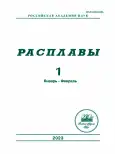THE DENSITY AND ELECTRICAL CONDUCTIVITY OF MOLTEN SALT MIXTURES OF BERYLLIUM FLUORIDE WITH ALKALINE METALS CHLORIDE
- Authors: Krylosov A.V.1, Polovov I.B.1, Rebrin O.I.1
-
Affiliations:
- Ural federal university named B.N. El’cin
- Issue: No 1 (2023)
- Pages: 89-98
- Section: Articles
- URL: https://journals.rcsi.science/0235-0106/article/view/138536
- DOI: https://doi.org/10.31857/S0235010623010061
- EDN: https://elibrary.ru/HEKXTS
- ID: 138536
Cite item
Full Text
Abstract
Information about the density and electrical conductivity of salt melts is of interest both for assessing the possibility of their use for electrolytic obtaining and refining of beryllium and other technological processes, and analyzing the possible interaction of components. Data on the density of molten saline systems containing fluoride and alkaline metals chloride are obtained by hydrostatic weighing. The balloon and the thread of the suspension were made of platinum. Berylia oxide used the material and cover of thermocouple. In system BeF2–MeCl (Me = Li, Na, K, Cs) и BeF2–(Li–K)eut–Cl investigated from 9 to 14 molten saline mixtures containing from 0 to 100% beryllium fluoride with an increase in temperature by 100–200 K from the melting point of the mixture with an average step of 10 K. Due to the behavior of the individual fluoride of beryllium when heated above the melting temperature (high viscosity and intense evaporation), the density of molten salt was measured by maximum pressure in the gas bubble. Simultaneously with the density of the capillary method, the electrical conductivity of these melts was measured. Material of the measuring cell—beryllium oxide, measuring electrodes—platinum rods with a diameter of 1 mm. The permanent cells were determined and regularly controlled by melting of high-purple potassium chloride. All operations for the preparation of saline mixtures, the selection of samples for chemical analysis and the measurement of properties were carried out in an isolated atmosphere of a dry and additionally cleaned argon. The measurement results are presented on the graphs and in the form of the first and second-order polynomas, reflecting the dependence of density and electrical conductivity on temperature for various compounds of saline mixtures. The values of the simultaneously measured density and electrical conductivity values were used to calculate the molar volume and molar electrical conductivity of electrolytes. The isotherms of the molar volume are almost linear in nature, which indicates the weak interaction of the components of the melt. The isotherms of molar electrical conductivity have a characteristic outrage in the area of compositions containing about 30 mol % beryllium fluoride, which may be associated with the formation of complex compounds in the liquid phase.
About the authors
A. V. Krylosov
Ural federal university named B.N. El’cin
Author for correspondence.
Email: avkrylosov@urfu.ru
Russia, Yekaterinburg
I. B. Polovov
Ural federal university named B.N. El’cin
Email: avkrylosov@urfu.ru
Russia, Yekaterinburg
O. I. Rebrin
Ural federal university named B.N. El’cin
Email: avkrylosov@urfu.ru
Russia, Yekaterinburg
References
- Delimarskij Yu.K., Zarubickij O.G. Elektroliticheskoe rafinirovanie tyazhelyh metallov v ionnyh rasplavah [Electrolytic refinement of heavy metals in ion melts]. M.: Metallurgiya, 1975. [In Russian].
- Shchegolev V.I., Lebedev O.A. Elektroliticheskoe poluchenie magniya [Electrolytic produce of magnesium]. M.: Ruda i metally, 2002. [In Russian].
- Petrov P.A., Sharikov Yu.V. Matematicheskoye modelirovaniye podsistemy upravleniya alyuminiyevym elektrolizerom s obozhzhennymi anodami [Mathematical modeling of the control subsystem of aluminum electrolyzer with burned anodes] // Tsvetnyye metally. 2006. 10. P. 81–84. [In Russian].
- Arkhipov P., Tkacheva O. The Electrical Conductivity of Molten Oxide-Fluoride Cryolite Mixtures // Materials. 2021. 14. 7419.
- Efremov A.N., Kulik N.P., Kataev A.A., Apisarov A.P., Red’kin A.A., Chujkin A.Yu., Arhipov P.A., Zajkov Yu.P. Elektroprovodnost’, plotnost' i temperatura likvidusa ekvimol’noy smesi KCl–PbCl2 s dobavkami oksida svintsa [Electrical conductivity, density and temperature of the liquidate of the equimate mixture of KCl–PbCl2 with additives of lead oxide] // Izvestiya vuzov. Tsvetnaya metallurgiya. 2016. 5. P. 10–16. [In Russian].
- Ivanovskij L.E., Hohlov V.A., Kazancev G.F. Fizicheskaya himiya i elektrohimiya hloralyuminatnyh rasplavov [Physical chemistry and electrochemistry of chloral melts]. M.: Nauka, 1993. [In Russian].
- Minchenko V.I., Stepanov V.P. Ionnye rasplavy: uprugie i kaloricheskie svojstva [Ionic melts: elastic and caloric properties]. Yekaterinburg: IVTE UrO RAN. 2008. [In Russian].
- Katyshev S.F., Desyatnik V.N. Plotnost’ i poverkhnostnoye natyazheniye rasplavov sistemy NaF–NaCl–ZrF4 [The density and surface tension of the melts of the NaF–NaCl–ZrF4] // Atomnaya energiya. 1998. 84. № 1. P. 61–64. [In Russian].
- Katyshev S.F., Shirokova N.V., Teslyuk L.M. Elektroprovodnost’ rasplavlennykh smesey LiCl–KF–ZrF4 [The electrical conductivity of molten mixtures LiCl–KF–ZrF4] // Elektrokhimiya. 2017. 53. № 5. P. 618–621. [In Russian].
- Smirnov M.V., Stepanov V.P., Hohlov V.A. Ionnaya struktura i fiziko–khimicheskiye svoystva galogenidnykh rasplavov [Ionic structure and physico-chemical properties of halogenid melts] // Rasplavy. 1987. № 1. P. 64–73. [In Russian].
- Shirokova N.V. Fiziko-himicheskie svojstva rasplavlennyh smesej ftorida cirkoniya s galogenidami shchelochnyh metallov [Physico-chemical properties of molten mixtures of zirconium fluoride with alkaline metals halogenes]. Avtoreferat diss. kand.himich. nauk. Yekaterinburg. 2010. [In Russian].
- Desyatnik V.N., Katyshev S.F., Raspopin S.P. Fiziko-khimicheskiye svoystva rasplavov tetrakhlorida urana s khloridami shchelochnykh metallov [The physicochemical properties of melts of uranium tetrahloride with alkaline metals chloride] // Atomnaya energiya. 1977. 42. № 2. P. 99–103. [In Russian].
- Klimenkov A.A., Kurbatov N.N., Raspopin S.P., Chervinskij Yu.F. Plotnost’ rasplavlennykh smesey ftorida berilliya s ftoridami shchelochnykh metallov // [The density of molten mixtures of ftoride beryllium with alkaline metals fluorides] // III Ural’skiy nauchnyy seminar po khim. reaktsiyam i prots. v raspl. elektrolitov: Tez. dokl. Perm’. 1982. P. 112–113. [In Russian].
- Rebrin O.I., Mordovin A.E., Nichkov I.F. Sistema BeCl2–LiCl [System BeCl2–LiCl] // Zhurnal neorganicheskoy khimii. 1985. 30. № 10. P. 2663–2665. [In Russian].
- Rebrin O.I., Nichkov I.F., Mordovin A.E. Plotnost’ i elektroprovodnost’ rasplavlennykh solevykh smesey khloridov berilliya i natriya [The density and electrical conductivity of molten salt mixtures of chloride of beryllium and sodium] // Zhurnal fizicheskoy khimii. 1983. LVII. № 3. P. 725–728. [In Russian].
- Rebrin O.I., Mordovin A.E., Nichkov I.F. Sistema BeCl2–CsCl [System BeCl2–CsCl] // Zhurnal neorganicheskoy khimii. 1986. 31. № 6. P. 1519–1521. [In Russian].
Supplementary files













